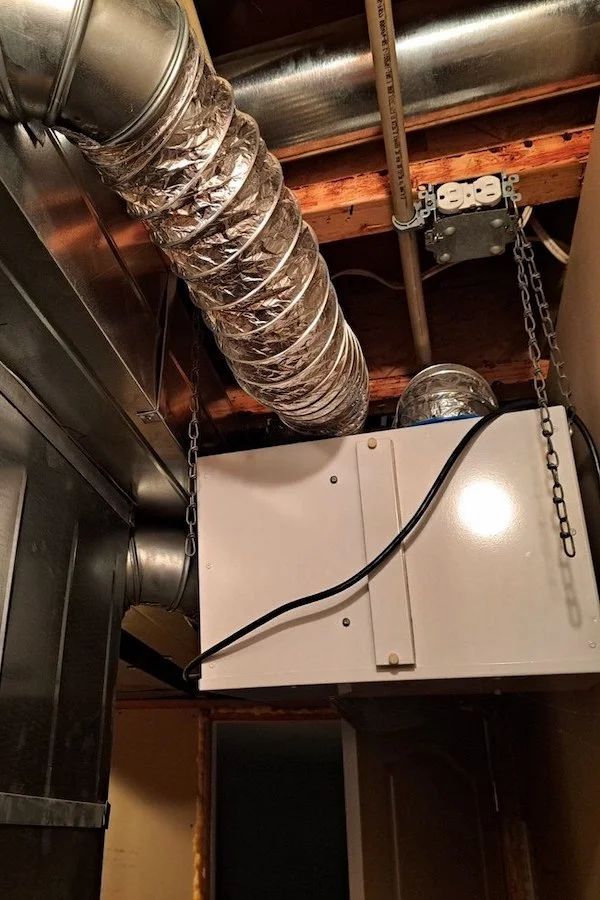What Is a Heat Recovery Ventilator?

Introduction to Heat Recovery Ventilators

A heat recovery ventilator (HRV) is a ventilation system that exchanges stale indoor air with fresh outdoor air while transferring heat to minimize energy loss, improving indoor air quality in energy-efficient homes.
Designed for climates with significant temperature differences, a heat recovery ventilator recovers up to 85% of the heat from outgoing air, reducing heating costs in cold regions like Quebec.
By providing continuous ventilation, a heat recovery ventilator prevents the buildup of pollutants, allergens, and excess humidity, ensuring a healthier living environment.
How Does an HRV Differ from Other Systems?

What is a heat recovery ventilator compared to other systems? Unlike exhaust-only ventilation, an HRV balances air intake and exhaust, maintaining indoor air pressure while recovering heat.
In contrast to an energy recovery ventilator (ERV), a heat recovery ventilator transfers only heat, not moisture, making it ideal for cold, dry climates where humidity control is less critical.
A heat recovery ventilator integrates with HVAC systems to enhance efficiency, reducing the energy needed to heat or cool incoming air in tightly sealed homes.
What Does a Heat Recovery Ventilator Do?
Core Function of an HRV

What does a heat recovery ventilator do? It extracts heat from stale indoor air and transfers it to incoming cold air, minimizing energy loss while refreshing indoor air quality.
By ventilating without significant heat loss, a heat recovery ventilator maintains comfortable indoor temperatures, especially during harsh Canadian winters, saving up to 20% on heating costs.
A heat recovery ventilator reduces indoor pollutants like CO2 and volatile organic compounds (VOCs), creating a healthier environment for occupants, particularly those with respiratory issues.
Components of a Heat Recovery Ventilator

The heat exchanger core in a heat recovery ventilator, typically made of aluminum or plastic, facilitates heat transfer between outgoing and incoming air streams without mixing them.
Dual fans in a heat recovery ventilator ensure balanced airflow, pulling in fresh air and expelling stale air through dedicated ducts for continuous ventilation.
Filters within a heat recovery ventilator trap dust, pollen, and other particles, protecting the system and improving indoor air quality for occupants.
- Choose a heat recovery ventilator with a high heat recovery efficiency (80% or more) for maximum energy savings.
- Ensure proper duct insulation to prevent heat loss in the heat recovery ventilator system.
- Opt for models with quiet fans, ideally below 1.5 sones, to minimize noise.
- Check for ENERGY STAR certification to qualify for rebates on your heat recovery ventilator.
- Regularly clean the heat exchanger core to maintain optimal heat recovery ventilator performance.
What Is an Energy Recovery Ventilator?
Comparing HRV and ERV

What is an energy recovery ventilator? An ERV transfers both heat and moisture, unlike a heat recovery ventilator, which only handles heat, making ERVs better for humid climates.
An energy recovery ventilator prevents overly dry or humid indoor air, while an HRV may dry out interiors in winter, which is preferable in colder, drier regions.
Choosing between an HRV and an energy recovery ventilator depends on your climate; HRVs excel in cold, dry areas, while ERVs suit humid or mixed climates.
What Is Energy Recovery Ventilation?

What is energy recovery ventilation? It’s the process of exchanging indoor and outdoor air while transferring heat and moisture to reduce energy loss and control humidity.
An energy recovery ventilator uses an enthalpy wheel or membrane to transfer both heat and moisture, unlike the heat-only focus of a heat recovery ventilator.
By incorporating humidity control, an energy recovery ventilator enhances comfort in regions with fluctuating humidity, complementing the heat-focused efficiency of an HRV.
What Is an ERV in HVAC?
ERV in the HVAC Context

What is an ERV in HVAC? An ERV is a ventilation component that recovers energy (heat and moisture) to precondition incoming air, reducing the workload on HVAC systems.
In contrast, a heat recovery ventilator in HVAC systems focuses solely on heat recovery, making it a specialized choice for cold climates where moisture control is less critical.
Both an ERV and a heat recovery ventilator integrate with furnaces or air conditioners, ensuring compliance with ventilation codes while enhancing energy efficiency.
What Is a ERV?
What is a ERV? It’s a ventilation system that transfers heat and moisture, balancing air quality and energy efficiency in homes or commercial spaces.
An energy recovery ventilator is particularly effective in humid climates, preventing mold growth by managing moisture levels, unlike a heat recovery ventilator.
In HVAC systems, an energy recovery ventilator supports sustainability goals by reducing energy consumption while maintaining fresh indoor air.
Applications and Suitability
Residential Use

A heat recovery ventilator is ideal for energy-efficient homes in cold climates, where maintaining heat during ventilation is critical for comfort and cost savings.
In tightly sealed homes, a heat recovery ventilator prevents stale air buildup, reducing health risks from pollutants and improving air quality for residents.
For allergy sufferers, a heat recovery ventilator with HEPA filters removes fine particles, creating a healthier indoor environment in modern residences.
Commercial and Industrial Applications

In offices, a heat recovery ventilator ensures fresh air for employees, reducing sick building syndrome while minimizing heating costs in large spaces.
Retail spaces and restaurants use a heat recovery ventilator to manage odors and maintain comfortable temperatures without excessive energy use.
Industrial facilities rely on a heat recovery ventilator to meet strict ventilation codes while recovering heat, supporting sustainability and operational efficiency.
Choosing the Best HRV
Top Models and Brands

The heat recovery ventilator from Lifebreath, like the RNC 205, offers up to 85% heat recovery efficiency and durable cores, ideal for cold climates.
Venmar’s AVS Solo series, a top heat recovery ventilator, features quiet operation and smart controls, making it a favorite for residential installations.
Fantech’s VHR 150, another leading heat recovery ventilator, provides reliable performance with easy maintenance, suitable for small to medium-sized homes.
Selection Criteria
Select a heat recovery ventilator with a capacity (50-200 CFM) matched to your home’s size to ensure effective ventilation without overworking the system.
Look for a heat recovery ventilator with high heat recovery efficiency (above 80%) and low noise levels (below 1.5 sones) for comfort and savings.
Choose a heat recovery ventilator with a warranty of at least 5 years on the core and 2 years on parts to protect your investment.
Installation and Maintenance
Professional Installation

Installing a heat recovery ventilator requires a certified technician to ensure proper ductwork, balanced airflow, and compliance with local building codes.
Improper installation of a heat recovery ventilator can lead to air leaks or reduced efficiency, increasing energy costs and compromising performance.
Installation costs for a heat recovery ventilator range from $2,000 to $5,000, depending on the home’s size and ductwork complexity.
Maintenance Requirements

Clean or replace the filters of a heat recovery ventilator every 3-6 months to maintain airflow and prevent dust buildup, ensuring optimal air quality.
Inspect the heat exchanger core of a heat recovery ventilator annually, cleaning it with mild soap to remove debris and maintain efficiency.
Schedule professional maintenance for a heat recovery ventilator every 2-3 years to check fans, ducts, and controls, costing $100-$200 per visit.
Performance in Cold Climates
Winter Operation

A heat recovery ventilator is essential in winter to ventilate sealed homes, preventing humidity buildup that can lead to mold while recovering heat.
In cold climates, a heat recovery ventilator reduces heating costs by transferring warmth from outgoing air to incoming air, maintaining indoor comfort.
Some heat recovery ventilators include preheaters to prevent core freezing in sub-zero temperatures, ensuring reliable operation during harsh winters.
Adjusting for Optimal Performance

Set the heat recovery ventilator to a moderate ventilation rate in winter to balance fresh air intake with heat retention, avoiding over-drying indoor air.
Clear snow or ice from the heat recovery ventilator’s exterior vents to maintain unobstructed airflow during winter storms.
Monitor indoor humidity levels with the heat recovery ventilator to ensure they stay between 30-50%, preventing overly dry air in cold months.
Cost and Incentives

Cost of a Heat Recovery Ventilator
A heat recovery ventilator costs $1,500-$4,000 for the unit, with installation fees of $2,000-$5,000 depending on ductwork and system complexity.
High-efficiency models like Venmar’s AVS E15 reduce energy costs, offering a return on investment within 5-7 years for a heat recovery ventilator.
Maintenance costs for a heat recovery ventilator are low, typically $100-$200 annually for filter replacements and professional servicing.
Available Incentives

In Canada, Hydro-Quebec offers rebates up to $1,000 for an ENERGY STAR-certified heat recovery ventilator, reducing upfront costs.
In the U.S., federal tax credits through 2025 cover 30% of the cost of a heat recovery ventilator, up to $600, under the Inflation Reduction Act.
Local utility programs may provide additional incentives for a heat recovery ventilator, so check with your provider to maximize savings.
Conclusion: Enhancing Home Comfort with an HRV
Why Invest in an HRV?

Understanding What is a heat recovery ventilator highlights its role in improving air quality and reducing energy costs, especially in cold climates.
A heat recovery ventilator is a smart choice for modern homes, offering health benefits, comfort, and efficiency without excessive energy loss.
By selecting a high-quality heat recovery ventilator and maintaining it properly, you ensure a healthier, more comfortable home for years to come.

How Heat Recovery Ventilators Improve Your Home’s Air and Efficiency +1 (819) 485 0516
What Is a Heat Recovery Ventilator?

Nous offrons des services complets de CVC à Gatineau, Québec, spécialisés dans le chauffage, la climatisation, les thermopompes et les échangeurs d’air pour des projets résidentiels et commerciaux. hvacgatineau@outlook.com


Contactez-nous
HVAC Gatineau Services de Chauffage, Climatisation et Ventilation
Si vous recherchez des solutions CVC de qualité près de chez vous, notre équipe d’experts chez HVAC Gatineau vous garantit des résultats durables pour l’installation, la réparation et l’entretien de systèmes de chauffage, climatisation, thermopompes et échangeurs d’air. Nous servons Gatineau, Hull, Aylmer, Buckingham, Masson-Angers et les environs. Contactez-nous pour un devis rapide sur vos besoins en CVC à Gatineau et dans les environs.

